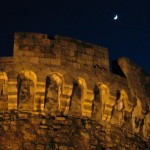The Zindan Gate was built in the middle of the 15th century for better protection of the East Gate, which at the time was the main entrance to the city. The gate is actually a small pre-fortification — a barbican consisting of two massive semicircular towers, between which there is a passage. The area towards the corner tower of the Upper Town was closed by an arched rampart, about 11 metres high. There used to be a moat in front of the gate, over which a wooden drawbridge stretched. Above the arch of the gate there was a small rectangular niche with a place for the icon of the protector of the city. There were seven cannon openings on the towers and the arched rampart of this complex. This was the place where the artillery defence system was applied for the first time, that is, a defence with firearms. It was from these positions that Belgrade successfully resisted the Turkish siege in 1456.
During the great Austrian works on the reconstruction of the Belgrade Fortress in the first half of the 18th century, the Zindan Gate Complex was thoroughly reconstructed. The towers were given brick arches, as well as masonry staircases with access corridors and the arched rampart was reinforced with an earthen embankment. During the 18th century, the towers probably served as dungeons, as evidenced by the current name of the gate — in Turkish, the word zindan means dungeon or prison.







